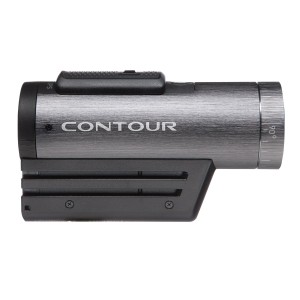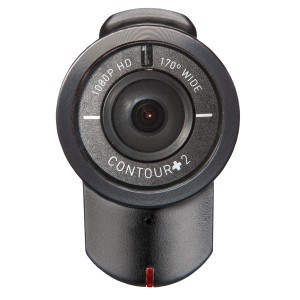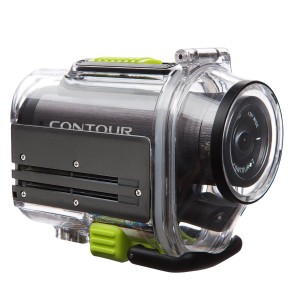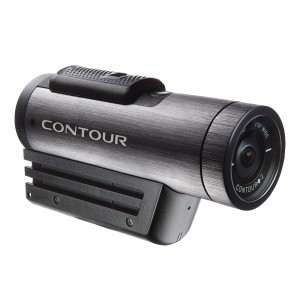Contour+2 vs GoPro
Contour have had a long history in the field of action cameras. Back in 2009, the Contour HD was the de facto competitor to GoPro’s first HD helmet cam, the Hero 1. Reviews praised the Contour’s more stylish aluminium sleek design over the GoPro’s boxy approach, and its simple switch to activate the recording, together with its trick laser levelling system. Overall though, the video quality of the GoPro was that bit better, and it quickly became established as the standard camera for action spots. Contour struggled to compete and, in August 2013 the company sadly closed its doors. That could have been the end of the story, but, following its purchase by Clarke Capital Partners, Contour has risen phoenix-like from the ashes, and has a new camera to compete against the GoPro Hero 3+ – the Contour+2. So, how does it stack up against the GoPro?
 Contour have stuck with their original sleek design for the +2 – effectively an aluminium tube with a mounting block with rails on the base. It feels solid and well made, and much less plasticky than the GoPro; indeed, it almost puts us in mind of bit of high grade military kit! On the top there is also the same simple sliding switch to operate the camera – slide forward to power up and record, and back to stop and shut down, with various LED indicators to show you what it’s up to. The back of the camera is where the various ports, SD card slot and battery are housed. Like the previous Contours, there is no screen at all – not even a simple LCD display like the GoPro’s for configuring the camera. However, whereas on the original camera this meant connecting it to a computer to change shooting modes, now the Contour +2 comes with wifi and a smartphone app, which allows the user to both change the settings on the camera, and review both live previews from the lens and previously recorded footage.
Contour have stuck with their original sleek design for the +2 – effectively an aluminium tube with a mounting block with rails on the base. It feels solid and well made, and much less plasticky than the GoPro; indeed, it almost puts us in mind of bit of high grade military kit! On the top there is also the same simple sliding switch to operate the camera – slide forward to power up and record, and back to stop and shut down, with various LED indicators to show you what it’s up to. The back of the camera is where the various ports, SD card slot and battery are housed. Like the previous Contours, there is no screen at all – not even a simple LCD display like the GoPro’s for configuring the camera. However, whereas on the original camera this meant connecting it to a computer to change shooting modes, now the Contour +2 comes with wifi and a smartphone app, which allows the user to both change the settings on the camera, and review both live previews from the lens and previously recorded footage.
 The Contour +2 also retains its predecessor’s party trick of a rotating lens with a laser indicator beam. This allows you to ensure that the lens is horizontal whatever angle the camera is mounted at and perhaps more importantly, to see exactly where the camera is actually pointing, and adjust it accordingly – hopefully leading to no more videos of mainly sky or mainly ground. However, it should be noted that the beam is very hard to see in bright sunshine
The Contour +2 also retains its predecessor’s party trick of a rotating lens with a laser indicator beam. This allows you to ensure that the lens is horizontal whatever angle the camera is mounted at and perhaps more importantly, to see exactly where the camera is actually pointing, and adjust it accordingly – hopefully leading to no more videos of mainly sky or mainly ground. However, it should be noted that the beam is very hard to see in bright sunshine
The mounting system for the Contour +2 is also the same as that on the original camera – it features rails on each side of the base of the camera which slide into the mounts themselves. Contour sell a number of mounts – for snowsports, the classic option is the goggle strap mount, which works well with the low profile of the camera, and makes it less obtrusive than a GoPro helmet mount. Contour also make mounts for helmets, handlebars, ski poles, suction mounts… in fact the range is one of the most extensive we’ve seen. However, the Contour rail mount doesn’t seem to hold the camera quite as firmly as GoPro’s mounting system, and the camera can move about a bit when on a bumpy trail. In addition, there have been a number of reports of users suffering broken mounts. The Contour +2 also features a conventional tripod socket on the base – this allows it to be used not only with tripods, but also with third party mounting systems – these might in fact provide a more secure mounting solution.
 While the Contour +2 has some resistance to moisture (and could be used on its own on a bluebird day of skiing, for example, it is recommended in situations where it may get wet, the waterproof case is used. This is shipped with the camera, and is well constructed, if a little chunky. The case makes the Contour +2 waterproof to a depth of 60m – the same as the GoPro. However, once in its case the Contour is significantly larger than the GoPro, so this is something to bear in mind if your planned use involves the possibility of getting wet.
While the Contour +2 has some resistance to moisture (and could be used on its own on a bluebird day of skiing, for example, it is recommended in situations where it may get wet, the waterproof case is used. This is shipped with the camera, and is well constructed, if a little chunky. The case makes the Contour +2 waterproof to a depth of 60m – the same as the GoPro. However, once in its case the Contour is significantly larger than the GoPro, so this is something to bear in mind if your planned use involves the possibility of getting wet.
The other feature of the Contour +2 (and which the GoPro also lacks) is the inclusion of GPS track recording. This is a neat touch, especially for sports like mountain biking and skiing. In order to use this functionality, however, it is necessary to load the videos into Contour’s “Storyteller” software to access this data, so it’s not something that is all that easy to access if you plan on using a third party bit of editing software like iMovie. In addition, the GPS function does eat up further battery power on the camera, so it’s worth considering if you really need the GPS data if you’re setting out for a long day’s filming.
 At the business end, the Contour +2 features a 170 degree wide angle lens – very similar to that found in the GoPro cameras. It can record high definition 1080p at 30fps, 720p at 60fps or standard definition 480p at 120p, and also take 5 megapixel still photos. This puts it pretty much on a par with the entry level GoPro Hero 3 White edition (though this lacks the 120fps standard definition mode). In terms of video quality, and comparing the Contour +2 with the GoPro Hero 3 White edition, both cameras produce high quality video, and there is not too much in it – we think the GoPro just edges it, as it seems to cope better with bright sunlight, high contrast situations. However, it also has to be remembered that the GoPro range now starts at the White and goes up to the Hero 3+ Silver and then the top of the line Black editions. These boast 1080p at 60fps and 120fps respectively, and therefore comprehensively beat the Contour if framerate is at all an issue (which of course in most action cam scenarios, it is).
At the business end, the Contour +2 features a 170 degree wide angle lens – very similar to that found in the GoPro cameras. It can record high definition 1080p at 30fps, 720p at 60fps or standard definition 480p at 120p, and also take 5 megapixel still photos. This puts it pretty much on a par with the entry level GoPro Hero 3 White edition (though this lacks the 120fps standard definition mode). In terms of video quality, and comparing the Contour +2 with the GoPro Hero 3 White edition, both cameras produce high quality video, and there is not too much in it – we think the GoPro just edges it, as it seems to cope better with bright sunlight, high contrast situations. However, it also has to be remembered that the GoPro range now starts at the White and goes up to the Hero 3+ Silver and then the top of the line Black editions. These boast 1080p at 60fps and 120fps respectively, and therefore comprehensively beat the Contour if framerate is at all an issue (which of course in most action cam scenarios, it is).
In conclusion, the Contour +2 camera has a lot of strong points. It’s arguably constructed of better materials than the GoPro, and potentially looks neater when mounted on the side of a helmet, and the built in GPS is a really nice feature. However, its mount design is not as good as the GoPro’s, and the Hero 3+ Silver and Black models have well and truly bested the resolution offered by the Contour camera. It will be interesting to see if Contour responses to this in the coming months and brings out an updated model with more competitive specs.
Price wise, the Contour +2 is selling for around $265. That puts it right in the middle between the GoPro 3 White at $200 and 3+ Silver at $300. Overall, we have to hand the win to the GoPro here – either the White for those on a budget, or the Silver for those who want that 1080p 60fps footage for an extra $100. However, the Contour still has plenty to recommend it, particularly to those who value the GPS tracking, or just prefer the way the Contour looks and feels. It’s a great camera, and we hope the company will keep on developing it further.
